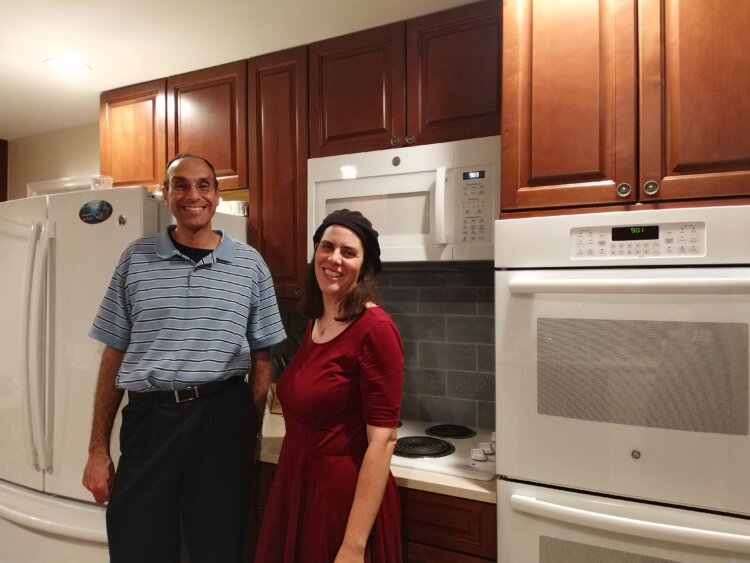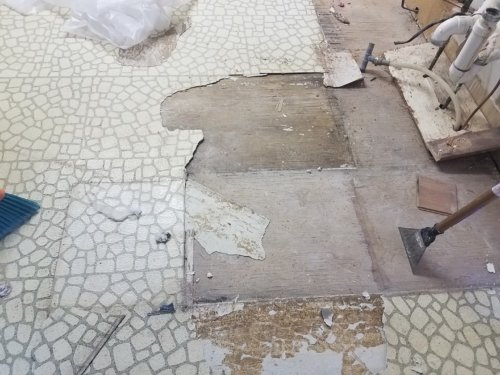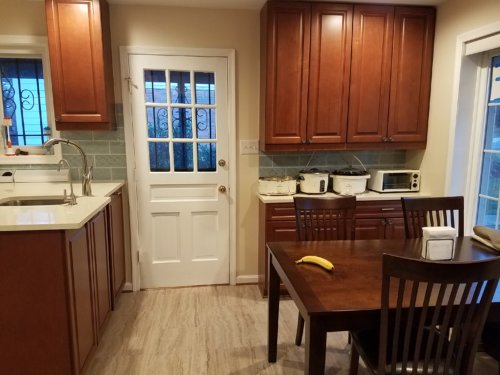
Longtime environmental educator Evonne Marzouk has spent much of her career helping to raise environmental awareness. So when she and her husband Jerry decided to redo the kitchen in their Silver Spring, Maryland home, they set out to create a space designed for their family’s needs that was also in alignment with their environmental principles.

We spoke with Marzouk and some of her contractors and advisers on the project to get the sustainability 411, complete with factors to consider and resources to consult for your own renovation.
Find the right contractor as partner. Marzouk worked with local sustainable businesses ecobeco and Amicus Green Building Center on her kitchen plan (receiving small discounts from them in return for promoting them when she shared about the renovation). Similar green businesses exist in some larger U.S. metro markets, including NYC, Chicago, San Francisco and LA, explained Amicus Green’s Jason Holstine, and a search for “green building products” may help to identify local equivalents. The U.S. Green Building Council offers a list of organizations, people and projects with environmental values. The locator tool at The Building Performance Institute can help you find a like-minded contractor. You can also look for contractors who are members of or have taken trainings at the National Environmental Health Association and the National Comfort Institute; affiliation with these organizations is a sign that they are working consistently with healthy home values, Marzouk said.
Consider doing an energy audit. An energy audit can help identify ways to save energy and assess need for air quality system upgrades. Ecobeco’s Reuven Walder notes that it will also help to identify if the home is at risk for trapping pollutants. Moisture from bathrooms, kitchens, crawl spaces, basements, etc. can create mold conditions, he explained, while cooking, cleaning supplies (even eco-friendly ones), furniture, carpets and flooring all give off gas. “Homes need a minimum amount of natural air exchange with the outside to dilute the accumulation of such pollutants,” he said. Extremely airtight homes with less natural air exchange need mechanical systems to avoid trapping pollutants.
Identifying your priorities.
- What do you need? For example, more storage space or working space, a better layout, a new look, more lighting, kosher accommodations.
- What are your goals? Goals should be a reflection of needs plus, for example, using materials that protect our environment, cutting utility use and carbon footprint, using locally sourced materials.
- What are your limitations? Pertaining to space or budget, knowing what local zoning laws will and won’t permit.
- What is your design taste? Patterns and colors, style, etc.
“Your project is MUCH MUCH more likely to go smoother if everyone involved is on the same page EARLY ON about your parameters,” Holstine said. He also suggested that sourcing as many materials as you can from one supplier can simplify logistics and shorten your shopping list.
For the Marzouks’ project, the contractors sourced most of the materials in accordance with their sustainability and design/lifestyle priorities: Jerry Marzouk is tall, so high countertops were a must; rounded edges were required to protect the kids; drawers were constructed to keep essentials within reach; and soft-closing hinges were added to close softly, avoiding the noise of slamming. But they also prioritized recycled and renewable materials.

Finding the right materials. “When considering the environment, sometimes the best choice is to buy nothing at all,” Marzouk said. “But when the time comes to make a big purchase, the natural world needs us to make healthy, environmental, sustainable choices now.”
- The Marzouks got the recycled countertops they’d dreamed of: made from both pre-industrial and post-industrial waste, including porcelain from tiles, sinks and toilets; glass from windows, containers and glassware; and mirrors from dwellings, buildings and factories.
- Their new Forest Stewardship Certified cabinets, made without added formaldehyde, are certified as coming from responsibly managed forests that provide environmental, social and economic benefits.
- The floors are made from cork “because it’s a renewable material and looks like tile but provides a softer floor which is better for both joints and falling dishes,” Marzouk explained. A style similar to the one used by the Marzouks can be found here. They used sustainable cork from Portugal, which you can read more about here.
- Lighting is key to both sustainability and aesthetic experience in a kitchen. In the Marzouks’ kitchen, LED lighting uses less energy than fluorescent lights.
- The small details in this kitchen show the many options for environmental choices. The backsplash tile is recycled and the door knobs and handles are made in the USA from 95% recycled bronze. Finally, the paints and wood finishes include no Volatile Organic Compounds (VOCs).
 The Marzouks’ new kitchen is so shiny and new, that it’s bananas!
The Marzouks’ new kitchen is so shiny and new, that it’s bananas!
Keep what works, recycle or repurpose what doesn’t. Marzouk’s kitchen was relatively small and the materials were old. When they began the project they intended to keep two dishwashers and a microwave, but only one dishwasher survived the transition to the new kitchen. They hoped to donate the oven, but it was too old to be reused. If your kitchen is newer and the appliances can be kept or repurposed, this is another way to avoid waste during a construction project. In any case, check with your county to see what is recyclable. The Marzouks’ waste went to a local transfer station (a trash and recycling facility) which recycles everything possible.
Are you thinking of making some kitchen changes or renovations with an eye toward sustainability? Check out these resources.
- Buildinggreen.com
- Greenhomeguide.com
- Green Building Alliance
- There are a number of local and state jurisdictions that have local green certification programs and lists—so ask your town/county/state
What about your own environmental impact? How are you working to improve your own carbon footprint? Are you giving up straws or other single-use plastics? Have you ever gone on a plastic fast like our editor-in-chief Christina Kelly? Are you having a love affair with the environment, like Mayim? Have you tried any of these hints on going green from a group of feminists? Tell us in the comments.


Grok Nation Comment Policy
We welcome thoughtful, grokky comments—keep your negativity and spam to yourself. Please read our Comment Policy before commenting.